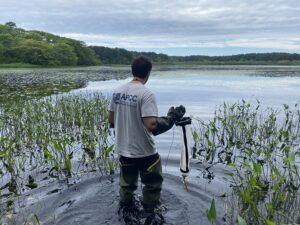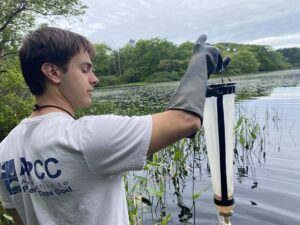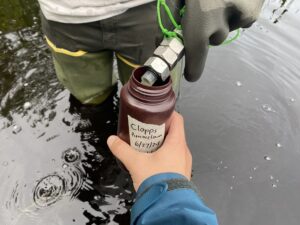PROVINCETOWN — Sophia Feuerhake and Jacob Scola meet at the entrance to Clapps Pond off Route 6 and unload a box full of equipment — tubes, nets, bottles, and a variety of sensors and meters — which they’ll use to test the water for cyanobacteria. It’s a ritual they began in late May and will repeat here every other week into the fall. And it’s one that is seen as increasingly important as people become more aware of the dangers of cyanobacterial blooms.

There are 890 ponds on Cape Cod, according to the Cape Cod Commission, and many are popular spots for swimming, hiking, and fishing. But these bodies of water can also host blooms of cyanobacteria, a type of bacteria that, though not usually harmful, can multiply explosively under nutrient-rich conditions and coat the water’s surface in a green paint-like scum.
The bacteria also can release poisons called cyanotoxins, like the liver toxin microcystin, which, in high concentrations, can make people and animals sick.
Feuerhake is the freshwater science coordinator at the Association to Preserve Cape Cod (APCC), and Scola is an intern in the organization’s cyanobacteria monitoring program, which aims to identify cyanobacteria blooms and use water quality measurements to predict when a bloom might soon take place.
The program, which started by monitoring five ponds in 2017, now monitors 134 ponds. All four Outer Cape towns lean on the APCC to coordinate monitoring in the 20 ponds in their purviews.
An Early Warning System
Dodging thick clouds of insects, Feuerhake and Scola make their way to a vantage point, where Scola dons a set of hip waders and enters the water. He measures the air and water temperatures, then begins to sample.

Taking out a long fine-meshed net on a string, he swings it over his head and hurls it into the pond, then pulls it toward him to scoop material off the surface. The resulting mix of pond plankton and water is poured into a bottle. Next, he uses a long tube to get a “whole-lake” sample of water at every depth of the pond and then fills a third bottle with water from just below the water’s surface.
The every-other-week testing lasts from late May until September or October, depending on the town. Some volunteer groups help APCC with the sampling steps. The Orleans Pond Coalition is one, and in Wellfleet, the Gull Pond Area Conservation Association, known as Gupaca, does some of the sampling.
At APCC, the samples are tested to establish how much cyanobacteria is in each pond. The tests work by comparing the amounts of chlorophyll in the water, which plants, algae, and cyanobacteria all have, with the amounts of phycocyanin in it. Only cyanobacteria produce phycocyanin.
If the ratio of phycocyanin in the comparisons rises over time, that’s a sign a bloom may be forming, said Julie Hambrook, who manages the APCC’s pond and cyanobacteria program.
Such a warning is vital information for town health departments, which can begin watching for cyanobacteria scum on the shore — an indication a bloom is underway. Blooms are dangerous, especially to children and pets, because they are more likely to drink from a pond and ingest the poisons in it.
If a scum forms, the APCC photographs it and sends the photo to the Mass. Dept. of Public Health for review. APCC also uses the surface samples they take with a net to identify which types of cyanobacteria are present. If more than 70 percent of a sample’s cyanobacteria are the often-toxin-producing Microcystis genus, they send a sample to Barnstable County’s Water Quality Laboratory, which analyzes the water for the toxin microcystin.
If the sample comes back with more than 8 parts per billion of the toxin, the county issues a health advisory — though Hambrook noted that towns usually close the ponds before that happens, typically when a visible scum appears on the water.
The towns pay for the monitoring work, Hambrook said, and most were keen on the help when APCC started its program — though some seemed reluctant to acknowledge any water quality issues, she said, adding that the thinking then was that talking about toxins in pond water was considered not good for tourism or the economy.
By now, Hambrook said, “people want to be aware. They don’t want the public to be in harm’s way.”
Another Toxin Comes in View
Microcystin is not the only toxin that cyanobacteria can produce. Another, a neurotoxin known as anatoxin, is also associated with blooms and may be similarly dangerous. It is hard to study, however, because it breaks down quickly, said Hambrook. This tendency does help keep people safe, as it tends not to linger in water like microcystin does.

The lack of research on it, however, means very little is known about the toxin — the Environmental Protection Agency doesn’t even have enough information to issue a drinking water advisory threshold for it, despite the fact that it can cause paralysis, loss of coordination, and death.
Anatoxin has not been linked to any deaths on Cape Cod, but it was found in Lower Mill Pond in Brewster in 2019 by then-University of New Hampshire master’s degree candidate Hailey Carter. Worried by this find, APCC began its own anatoxin pilot study this year.
It remains to be seen whether this research will find any more anatoxin in Cape Cod ponds, but Hambrook said that she hopes it will help clarify the relationship between different types of cyanobacteria and the toxins they produce.
The Future of Blooms
While local pond-goers’ experiences confirm that the appearance of cyanobacteria has risen over the last decade or so, it is hard to say whether there are more cyanobacterial blooms than there were longer ago.
For one thing, there’s no solid data on cyanobacteria from before 2017. And for another, it may be that the acid rain that made our Outer Cape ponds so crystalline before the Clean Air Act came along, may have helped prevent the development of cyanobacteria for a time — though that contamination obviously had its own drawbacks.
We do know that warmer temperatures make blooms more common, said Hambrook. So, climate change is likely to make cyanobacteria and its toxins a more common concern. Nutrients like phosphorus and nitrogen entering ponds through stormwater runoff, septic systems, and plant fertilizer can also promote these blooms, as cyanobacteria need these nutrients to reproduce.
While runoff is a problem out here, Hambrook said she thinks that people are changing some of their ways. Replacement of cesspools and older septic systems may be happening slowly, but Hambrook said she knows people have reduced the amounts of fertilizer they use on their lawns. “People really care about their ponds,” she said.



